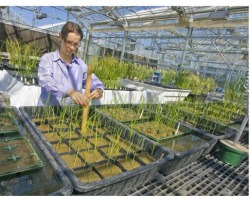The Most Common Hydroponic Systems

There are different methods that can be used in hydroponics which is growing plants without the use of soil. The concern lies on how to place the plants that will expose the roots to a constant supply of nutrient formula. This can be carried out in several ways, some more effective than others. Hydroponic systems have four categories the active which uses a pump, the passive, the recovery which requires recirculation of the solution, and the non-recovery. Also, most systems will use some kind of grow tray to hold the plants, and a reservoir which holds the solution. Here are a few popular hydroponic systems you might be acquainted with.
Ebb and Flow
In this active recovery method, plants in the grow tray are usually anchored by some sort of carrier (ideally one that retains water, like rockwool). A pump motor floods the grow tray with water occasionally based on the time you set on the timer, it then shuts down and lets the nutrient solution drain through a maze of tubes attached to the tray that leads back to the reservoir. Also known (for obvious reasons) as flood-and-drain, this method is a popular choice for newbies.
The Drip System
This active method is similar to ebb and flow, with the exception that rather than flooding the grow tray, the pump sends the solution through a network of tubes that drip the solution directly onto the plant roots. This hydroponic systems can be both recovery or non-recovery, depending on whether you strain the solution back into the reservoir. The non-recovery variation is more low-maintenance because you do not have to keep track of the pH of the reservoir nearly as much.
The Wick System
This is a basic, passive non-recovery hydroponic system in which the nutrient solution is carried from the reservoir to the plant roots by means of a wick (like an oil lamp wick). There's no need for a pump and for water circulation thus making this system easy and low-cost. However, it also tends to be much less productive because it is tougher to regulate the water flow, which means (depending on the type and quantity of plants) there can be either too much or too little mixture getting to the roots.
Nutrient Film Technique
Also called NFT for short, this is an active recovery system in which the plant roots are hanging in a regular flow (or film) of solution. A tube is used as a grow tray and the plants are hanged on top while the roots are dangled and open beneath. With the pump the solution goes through one tube and drains on the other end and into the reservoir. This method may be effective but it can be complicated and high-maintenance at the same time.
There are several variations of hydroponic systems but the ones pointed out are the most popular. Which hydroponic systems you select will depend mainly on your skill level and funds.
Ebb and Flow
In this active recovery method, plants in the grow tray are usually anchored by some sort of carrier (ideally one that retains water, like rockwool). A pump motor floods the grow tray with water occasionally based on the time you set on the timer, it then shuts down and lets the nutrient solution drain through a maze of tubes attached to the tray that leads back to the reservoir. Also known (for obvious reasons) as flood-and-drain, this method is a popular choice for newbies.
The Drip System
This active method is similar to ebb and flow, with the exception that rather than flooding the grow tray, the pump sends the solution through a network of tubes that drip the solution directly onto the plant roots. This hydroponic systems can be both recovery or non-recovery, depending on whether you strain the solution back into the reservoir. The non-recovery variation is more low-maintenance because you do not have to keep track of the pH of the reservoir nearly as much.
The Wick System
This is a basic, passive non-recovery hydroponic system in which the nutrient solution is carried from the reservoir to the plant roots by means of a wick (like an oil lamp wick). There's no need for a pump and for water circulation thus making this system easy and low-cost. However, it also tends to be much less productive because it is tougher to regulate the water flow, which means (depending on the type and quantity of plants) there can be either too much or too little mixture getting to the roots.
Nutrient Film Technique
Also called NFT for short, this is an active recovery system in which the plant roots are hanging in a regular flow (or film) of solution. A tube is used as a grow tray and the plants are hanged on top while the roots are dangled and open beneath. With the pump the solution goes through one tube and drains on the other end and into the reservoir. This method may be effective but it can be complicated and high-maintenance at the same time.
There are several variations of hydroponic systems but the ones pointed out are the most popular. Which hydroponic systems you select will depend mainly on your skill level and funds.
